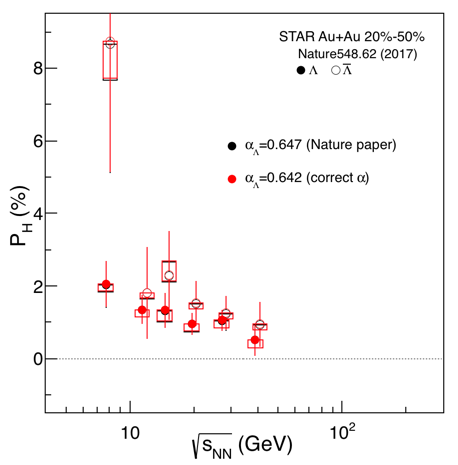Issue on Lambda decay parameter
During HEPData upload process for new alpha parameter, it was found that Lambda decay parameter used in Nature paper was wrong but the difference is small. The paper states that alpha is 0.642 but actually 0.647 was used. This is to check if the effect is visible in the plot and if the quoted average value over energies in the paper is also affected.
The plot below is comparison of global polarization PH from Nature paper (wrong alpha=0.647 is used) and rescaled, corrected values by PH*alpha_wrong/alpha_correct. As one can see, the effect is within uncertainties, however there are visible differences especially for anti-Lambda at 7.7 GeV. Note that y-axis range is same as the original paper.
(also see better resolution plot in attachment)
 PH with wrong alpha vs correct alpha
PH with wrong alpha vs correct alpha
Also the paper presents average polarization value over energies for Lambda and anti-Lambda:
"Taken in aggregate, the data are statistically consistent with the hypothesis of energy-independent polarization of 1.08 ± 0.15 (stat) ± 0.11 (sys) and 1.38 ± 0.30 (stat) ± 0.13 (sys) per cent for Λ and Λ , respectively."
To check the effect from the alpha issue, average values were calculated where the inverse of squared statistical error was used as weight. Need to ask PAs how actually they were calculated. The calculated average PH using the published values (alpha=0.647) are as follows:
Lambda: 1.0835 +- 0.1541 +- 0.0941 (%) -> 1.08 +- 0.15
anti-Lambda: 1.3834 +- 0.2985 +- 0.0828 (%) -> 1.38 +- 0.30
These are consistent with the numbers in the paper, mean values and statistical uncertainties but not for systematic uncertainties. Maybe the way to calculate average syst. uncertainty is different. Then average PH with correct alpha=0.642 was calculated.
Lambda: 1.0920 +- 0.1553 +- 0.0949 (%) -> 1.09 +- 0.16
anti-Lambda: 1.3942 +- 0.3008 +- 0.0835 (%) -> 1.39 +- 0.30
Recalculated values are slightly different from the numbers in the paper, although they are very close and consistent within uncertainties.
- taknn's blog
- Login or register to post comments
